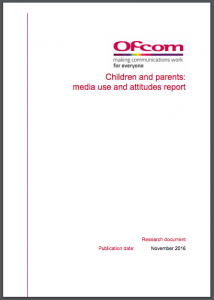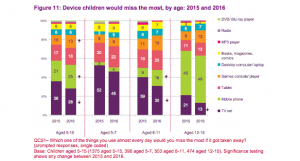
After more than 40 years of operation, DTVE is closing its doors and our website will no longer be updated daily. Thank you for all of your support.
Ofcom: kids spend more time online than in front of the TV
 For the first time children aged five to 15 now spend more time online than they do watching TV sets, according to Ofcom research.
For the first time children aged five to 15 now spend more time online than they do watching TV sets, according to Ofcom research.
The UK broadcast regulator’s ‘Children and Parents: Media Use and Attitudes’ report claims that in the past year children have increased their weekly online time by 1 hour and 19 minutes to 15 hours.
By contrast, 5-15 year olds now watch an average of 13 hours and 36 minutes of TV per week, a decline of 1 hour and 12 minutes compared to 2015.
These broad trends differ with age. Five to seven year-olds continue to spend more time watching TV, 8-11s now spend similar amounts of time online as watching TV, while 12-15s continuing to spend more time online than watching TV on a TV set.
However, when asked whether they prefer watching YouTube or watching TV programmes on a TV set, both 8-11s and 12-15s were “much more likely to opt for YouTube”. Some 42% of 8-11s said they preferred YouTube to TV, compared to 18% who opted for TV. Among 12-15s the split was 41% for YouTube and 16% for TV.
Overall, YouTube was found to be one of the most popular online destinations for children to watch content, with 73% of those aged 5-15 using the video site. By age group, 37% of 3-4s, 54% of 5-7s, 73% of 8-11s and 87% of 12-15s use the video site.
“Children are watching a wide range of content, with the TV set becoming an increasingly important focus for family time and children using portable devices for more focused, solitary viewing,” according to the report.
Ofcom noted that while younger children mostly use YouTube to watch traditional, ‘TV-like’ content, as children get older their content tastes change, with vloggers, music videos, game tutorials and joke or prank videos all preferred over TV programmes or clips.
or clips.
While children are watching less content on TV, Ofcom said that viewing changes do not mean children are consuming less content.
The number of children watching paid video-on-demand and watching online video clips has increased since 2014, and watching content alone on personal devices also appears to be on the rise.
Some 34% of children aged 3-4 were found to own their own media device – such as a tablet or games console. One in three 8-11s and 80% of 12-15s now have their own smartphone.
“Children’s lives are increasingly digital, with tablets and smartphones commanding more attention than ever. Even so, families are finding time for more traditional activities, such as watching TV together or reading a bedtime story,” said Ofcom director of market intelligence, Jane Rumble.


